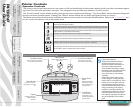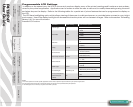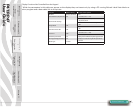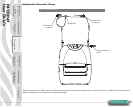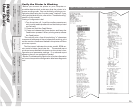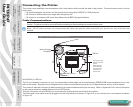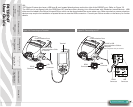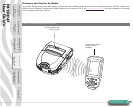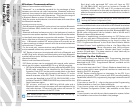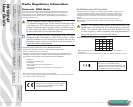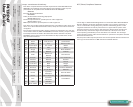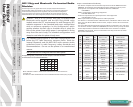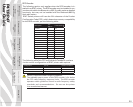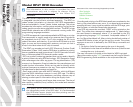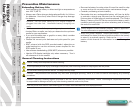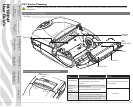
P4T/RP4T
User Guide
30
Wireless Communications
Wireless Communications with Bluetooth
®
“Bluetooth” is a worldwide standard for the exchange of data
between two devices via radio frequencies. Bluetooth radios are
relatively low powered to help prevent interference with other de-
vices running at similar radio frequencies. This limits the range of
a Bluetooth device to about 10 meters (about 32 feet).
Both the printer and the device it communicates with must follow
the Bluetooth standard.
Bluetooth Networking Overview
Each Bluetooth enabled P4T series printer has a unique Bluetooth
Device Address (BDA) loaded into its radio module when manu-
factured.
Bluetooth software is always running in the background, ready to
respond to connection requests. One device (known as the master
or the client) must request a connection with another. The second
device (the slave or the server) then accepts or rejects the connec-
tion. A Bluetooth enabled P4T series printer will normally act as
a slave creating a miniature network with the terminal sometimes
referred to as a “piconet.”
For the most part, communications using Bluetooth are initiated
and processed without any operator intervention.
P4T Series printers can be equipped with both a Bluetooth and
an 802.11b/g radio, allowing communications with both Bluetooth
enabled devices and a Wireless Local Area Network (WLAN) (see
discussion below).
Wireless Local Area Network Overview
P4T Series printers can be equipped with several radio options
which use the industry standard 802.11b or g WLAN protocols.
• P4T Series Wireless Network Printers with the Zebra 802.11b/g
WLAN radio module can be identified by the Product Con-
figuration Code (PCC) on the serial number label on the back
of the printer. Printers with this option will have a “K” as the
seventh character of the PCC Code. Printers with this option
may also be identified by the FCC ID: I28-PLAN11BG, or the
Industrie Canada ID: 3798B-PLAN11BG on printers built for the
North American region.
• P4T printers with both an 802.11b/g WLAN radio and a
Bluetooth radio running in the same unit are considered to be
dual radio devices. Printers with this option will have an “A”
as the seventh character of the PCC Code.
RP4T model printers cannot be configured with the 802.11g/
Bluetooth dual radio option.
Such dual radio equipped P4T units will have an FCC
ID: I28-ZB4LAN-01 and and an Industrie Canada ID:
3798B-ZB4LAN01. The FCC and IC ID numbers and other
regulatory information for this radio configuration are also lo-
cated on the serial number label of printers built for the North
American region.
Refer to Appendix D of this manual for more information on
locating the Product Con guration Code.
Printers equipped with either of the 802.11b/g radio options allow
wireless communication as a node within a WLAN and its wireless
capabilities allow communications from any point within the WLAN’s
perimeter. P4T printers equipped with the dual Bluetooth/802.11b/g
WLAN radio configuration can be linked to both a WLAN and a
Bluetooth network simultaneously.
Methods of establishing communications to P4T Series print-
ers will vary with each LAN application. General information on
establishing WLAN communications can be found in either the
”CPCL Programmers Manual” or the “Quick Start Guide for Mobile
Wireless Printers” both available on-line at the Zebra Web site
www.zebra.com/manuals. More information and LAN configura-
tion utilities may also be found in Zebra’s Label Vista™ program
(version 2.8 and later). The latest version of Label Vista may be
downloaded from Zebra’s Web site.
Setting Up the Software
P4T Series printers use Zebra’s CPCL Programming language
which was designed for mobile printing applications. CPCL is fully
described in the ” CPCL Programmers Manual”, available on-line
at the Zebra Web site.
You can also use Label Vista™, Zebra’s Windows based label cre-
ation program which uses a graphical interface to create and edit
labels in the CPCL language.
All P4T Series printers support an interpreter for the ZPL II pro-
gramming language. RP4T printers (with RFID encoding/reading
capabilities) use the ZPL programming language’s extensive set of
RFID commands.
If you plan to use ZPL II , refer to the appropriate Programming
Guides available on-line from Zebra’s Web site.
If you have a printer with wireless capabilities, you can refer to
the “Wireless Configuration Guide.” also available on the Zebra
web site.
If you choose to use a third party label preparation system, follow
the installation instructions included in the package.
Printer Preparation
pg. 7
Connecting the
Printer pg. 27
Radio Regulatory
Information pg. 31
RP4T Printers pg.
35
Maintenance pg. 36
Troubleshooting pg.
38
Speci cations pg.
43
Appendices pg. 46 Index pg. 52
P4T Overview-
pg. 5
Manual
Introduction pg. 4



